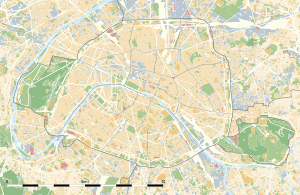Place d'Italie (Paris Métro)
| Paris Métro station | |||||||||||||||||||||
|
| |||||||||||||||||||||
| Location |
182, boul. Vincent Auriol 2, rue Bobillot Place d'Italie 146, boul. de l'Hôpital 13th arrondissement of Paris Île-de-France France | ||||||||||||||||||||
| Coordinates | 48°49′53″N 2°21′20″E / 48.831483°N 2.355692°ECoordinates: 48°49′53″N 2°21′20″E / 48.831483°N 2.355692°E | ||||||||||||||||||||
| Other information | |||||||||||||||||||||
| Fare zone | 1 | ||||||||||||||||||||
| History | |||||||||||||||||||||
| Opened | 24 April 1906 | ||||||||||||||||||||
| Services | |||||||||||||||||||||
| |||||||||||||||||||||
| Location | |||||||||||||||||||||
 Place d'Italie Location within Paris | |||||||||||||||||||||
Place d'Italie (French pronunciation: [plas ditali], literally "Italy Square") is a rapid transit station of the Paris Métro located in the heart of the 13th arrondissement of Paris, at the Place d'Italie. It is the terminus of Line 5 and is also served by Line 6 and Line 7.
History
The first platforms opened as part of the former Line 2 South on 24 April 1906, when it was extended from Passy. On 17 December 1906, Line 2 South was extended to Lancry. On 14 October 1907 Line 2 South was incorporated into Line 5. On 1 March 1909, Line 6 was opened from Place d'Italie to Nation. The Line 7 platforms opened on 15 February 1930 as part of a planned section of line Line 7, which was temporarily operated as part of Line 10 until the completion of the under-Seine crossing of line 7 from Pont de Sully to Place Monge. The station was integrated into line 7 on 26 April 1931. On 12 October 1942, the Place d'Italie Étoile section was transferred from line 5 to line 6 in order to separate the underground and elevated sections of the metro (because the latter were more vulnerable to air attack). As a result Line 5, rather than Line 6, terminated at Place d'Italie.
Location
_1819.jpg)
The Place d'Italie was the site of the Barrière d'Italie, a gate of in the Wall of the Farmers-General, built to enforce tax collections on goods entering Paris between 1784 and 1791, where the old Roman road towards Lyon and Rome began. The station is situated at the crossing of five large Parisian streets: the Avenue d'Italie, the Boulevard Auguste Blanqui, the Avenue des Gobelins, the Boulevard de l'Hôpital, and the Boulevard Vincent Auriol.
Entrances and exits
There are four access points to Place d'Italie station:
- Auguste Blanqui: one stairway at 2 Rue Bobillot
- Grand Écran: one stairway at Place d'Italie
- Vincent Auriol : one stairway and one escalator 182 Boulevard Vincent-Auriol
- Mairie du XIIIème : one stairway at 146 Boulevard de l'Hôpital
Nearby Attractions
- The mayor's office of the 13th arrondissement.
- The "Big Screen Building," a work of the Japanese architect Kenzo Tange, which includes offices, movie theaters, and shops.
Station layout
| Street Level |
| B1 | Connecting level |
| Lines 5/6 platforms | |
| Northbound Line 5 | |
| Northbound Line 5 | |
| Westbound Line 6 | ← |
| Eastbound Line 6 | |
| Line 7 platforms | ||
| Southbound | ← | |
| Northbound | | |
Gallery
-

Line 5 platforms at Place d'Italie
-
Line 6 platforms at Place d'Italie
-
Line 7 platforms at Place d'Italie
-
MF 67 rolling stock on Line 5 near Place d'Italie
Sources
- Métropole
- Pierre Miquel, Petite Histoire des Stations de Métro. Paris: Éditions Albin Michel, 1993.
| Wikimedia Commons has media related to Place d'Italie (Paris Metro). |
| Paris Métro | Line 7 | |||||||||||||
|---|---|---|---|---|---|---|---|---|---|---|---|---|---|---|
| ||||||||||||||


